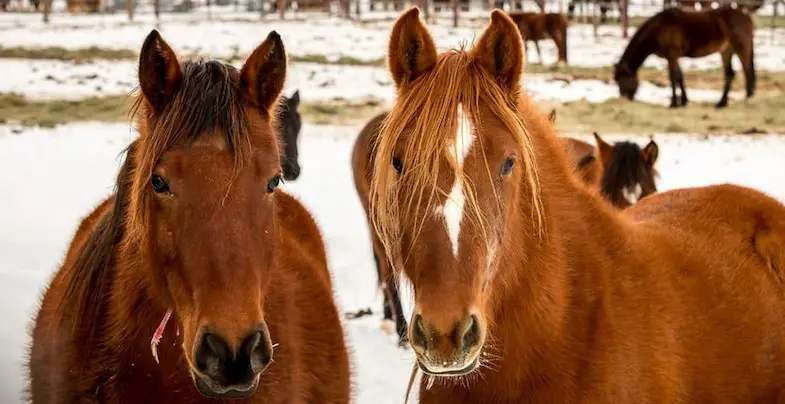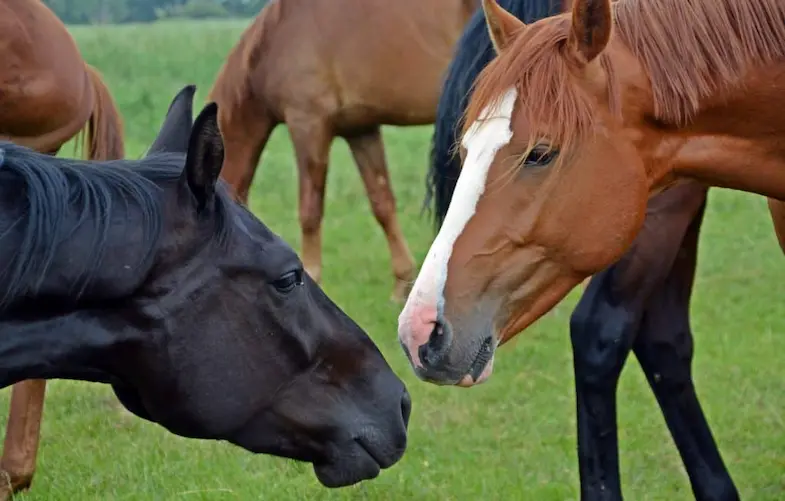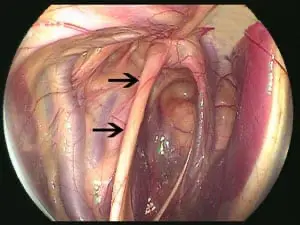Equine distemper, or strangles as its more commonly known, is probably the most common respiratory condition in horses and while it’s generally not considered fatal it can still be serious. It’s also extremely contagious and can result in a horse (or horses) being quarantined for weeks. The good news though is that, as with a lot of bacterial infections, it can not only be prevented but is also relatively easy to treat.
What is strangles?
Strangles is a bacterial infection (caused by the bacteria known as Streptococcus equi) that affects the horse’s upper airway and lymph nodes. It causes the pharynx, larynx, and trachea to swell and can, if not treated, block the airways – the name strangles actually comes from the fact that, before modern treatments, horses were often suffocated, as if they’d been strangled.
What are the first signs of strangles?
Once a horse has been infected with strangles he may not display any symptoms immediately but within three to fourteen days there’ll be obvious signs that he has strangles. While not every horse will display every symptom the common signs to look out for are:
- A sudden loss of appetite
- Difficulty swallowing
- Reluctance to drink
- High temperature (typically between 103°F – 106°F (39.4°C – 41.1°C))
- Wet coughing fits
- Raspy, strained breath
- Lethargy and depressed attitude
- Yellowy discharge from nose and eyes
- Abscesses in lymph nodes of head and neck
Abscesses can also form in other parts of the horse’s body (such as the abdomen, lungs and even the brain) but this is due to complications.
What causes strangles in horses?
Strangles is caused by the Streptococcus equi and for a horse to become infected he needs to have been exposed to the bacteria which can happen when he comes into contact with an infected horse or a horse that is a carrier. The contact doesn’t need to be direct, it can also be indirect which is why it’s important to not share equipment with infected horses.
The bacteria enters the horse’s body through his nose and mouth and then quickly moves to the throat. Once it’s in the throat it will start to infect the tonsil cells and then spread to the lymph nodes.
How can I prevent my horse from getting strangles?
As the saying goes, prevention is better than cure and strangles is no different. While it can be vaccinated against this is only a short term preventative measure. Long term prevention is harder but if you’re careful you can drastically lower the risk.
Strangles is highly contagious so stopping the yard from being overcrowded is vital, but it’s also important to not share tack or other equipment with other horses unless you’re 100% sure they don’t have strangles or aren’t a carrier.
If you travel a lot or spend a lot of time at shows make sure you take your own buckets and even your own water if you can. It’s also advisable to not let your horse come into contact with horses you don’t know. Horses that are infected may not show signs straight away so it’s also a good idea to wash your outer clothing as well as clean and disinfect your boots along with your horse’s equipment and your trailer when you get home.
Some yards insist on new horses being tested before arrival and then a two week period of quarantine after they arrive. I know this may sound extreme but it’s one of the most effective ways of keeping the yard, and therefore the horses, safe and free from strangles.
Are there any complications associated with strangles?
Thanks to modern advances in medicine strangles itself is very rarely fatal these days although there are complications that can, sometimes, prove to be fatal.
- Bastard strangles – This is considered a chronic form of strangles and occurs when the infection spreads to other parts of the body, typically the abdomen, lungs, and even the brain. This often results in abscesses forming in these areas that can rupture, with fatal consequences.
- Purpura hemorrhagic – Thankfully this is rare but its caused by the infection causing the capillaries to bleed. In its mildest form, red spots will form on the skin and around the membrane of some organs. Swelling of the limbs, head and other areas of the body can also happen, known as edema, this is more common in younger horses though.
- Asphyxia – This can happen if the lymph nodes swell too much and put pressure on the larynx and windpipe, this compresses them and stops the horse from being able to breathe.
- A horse can stay contagious – Even after a horse has recovered they can still remain contagious for around six weeks. While this might not sound like an issue it means that the horse’s glands are still carrying the infection which can be passed onto other horses.
Other, less serious, complications can include inflammation of heart muscles, anemia, inflammation of the tissue and paralysis of the muscles in the throat. While these can obviously be very disturbing and, of course worrying, they’re not fatal.
How long does it take for a horse to recover from strangles?
Around 90% of horses will make a full recovery, and will no longer be infectious, within three to four weeks but this isn’t the case for 10% of horses. While those horses will have made a full recover they can still carry the infection and as a result of this can easily infect other horses.
How do I treat strangles in my horse?
There’s no one treatment plan for all horses with strangles, instead, each horse is treated on a case by case basis. That said, in most cases, the disease is allowed to run its course with the aid of anti-inflammatories, these are used to reduce the horse’s temperature but also to help him feel well enough to start eating again.
You can encourage the abscesses to drain away by using a hot compress, this will help bring them to the surface where they then rupture and start to drain. Feeding your horse wet food on the floor will not only make it easier for him to swallow but will also help the abscesses to drain quicker because his head is lower.
Should you quarantine a horse with strangles?
Without question, all horses with strangles should be quarantined for at least two weeks but in some cases four weeks. Quarantining doesn’t just mean the horse needs to be stabled, to stop it from spreading to other horses, the quarantined horse needs to be kept at least 10m (33 feet) away from other horses, ideally, a separation distance of 25m (82 feet) is better. As well as keeping the horse away from other horses, all equipment needs to be kept separate too.
Some yards will also insist that new horses are quarantined for two weeks upon arrival. This is because a horse that has been exposed to strangles will start to show symptoms within two weeks. After the two weeks, the horse is then free to mix with the other horses in the yard.
Can a horse still remain infectious after they’ve recovered from strangles?
After most horses have fully recovered they’re no longer infectious but around 10% of horses are classed as ‘carriers’ this means that they are still infectious, even though they’ve fully recovered, and can still infect other horses.
This happens because the infection isn’t drained away with the discharge and instead stays in the horse’s guttural pouches (These are the pouches that sit at the back of a horse’s throat on either side. When an abscess in the lymph node bursts it does so into these pouches and normally drains away through the nose). Your veterinarian will be able to see if your horse is a carrier by performing a guttural pouch endoscopy, he’ll then be able to examine for pus and will also take samples. He’ll be able to ‘flush’ or wash the pus away and will then probably prescribe a course of topical antibiotics (normally penicillin), your horse will then be able to live a normal life and will no longer be a carrier.
Is there a vaccine for strangles?
The short answer is yes there is a vaccine (a submucosal injection administered on the inside of the top lip) but you should be careful when you vaccinate against it. There is evidence that if a horse already has strangles then, vaccinating against it at that stage, carried a high risk of adverse reactions, Purpura hemorrhagic is one of those associated risks.
If you’re moving a horse to a new yard, or are traveling to a show then you might want to consider vaccination but there are again drawbacks to that. While the vaccine is effective it doesn’t last and certainly isn’t effective in the long term.
There is, however, good news on the horizon when it comes to vaccinating against strangles. Various trusts around the world have been working to find an effective long term vaccination and have discovered a protein-based vaccine that, in tests at least, has proved to be effective. At the moment they’re still going through the test phase but these are going well and its hoped that they’ll be granted a worldwide license soon.
Do I have to tell people my horse has strangles?
Every state/country is different and will have their own laws and regulations but strangles is highly contagious and as such is generally considered a notifiable disease. This means that you’ll need to report any cases or even suspected cases. A lot of authorities keep the information confidential unless the owner has agreed to the information being released.
If you’re selling a horse that has strangles then you must let the perspective owner know and won’t be allowed to transport the horse until weeks after the horse has been given the all-clear. If you’re buying a horse, on the other hand, and want to make sure he doesn’t have strangles you can ask a veterinarian to perform a blood test. This normally takes a couple of days and will let you know if the horse has the antibodies.
Can humans get strangles from horses?
While the chances of us contracting strangles from horses are extremely rare it’s not impossible.
The only real way for it to be transmitted to us is for the discharge to get into our eyes, nose and, or mouth so it’s always good practice to wear disposable gloves while around horses that have strangles and try to avoid touching their face. It’s also a good idea to thoroughly wash your hands after you’ve finished.
It’s worth noting that the above is also true for cats and dogs in that they are highly unlikely to get strangles from horses. They can, like us, carry it though on their fur (or clothing in our case) which can then be passed onto horses.
Further reading
- Treating ulcers naturally
- How to manage arthritis in horses
- Caring for an old horse
- Do horses get depressed?
- How do horses sleep?
- Feeding a hard keep on a budget
- Feeding a horse with no pasture
- Is my horse healthy?
- Preparing your horse for winter
- What are your horse’s teeth telling you?
I hope you found this article helpful. If you did I’d be grateful if you could share it please as it would really help me.
Recommended products
Over the years I have tried hundreds of different horsey products, from various blankets and halters to different treats. Some I’ve loved, others I’ve hated but I thought I’d share with you my top all-time favorite products, the ones I never leave the yard without. I’ve included links to the products (which are in no particular order) that I really think are great.
- Horse Knots by Reference Ready – If you’re like me and enjoy pocket reference guides then you’ll love this knot tying guide. These handy cards can easily fit in your pocket or attach to the saddle for quick reference. They’re waterproof, durable and are color coded to make them easy to follow.
- Mane ’n Tail Detangler – Even if you never show your horse you’ll need to detangle his tail from time to time (and possibly his mane too) which is always a challenging chore! I’ve found that if I run a little bit of detangler through my horse’s tails every few days it stops them from getting matted up and makes combing them easy, even if they’re coated in mud. I don’t know if I should admit to this or not but it also works wonders on my hair.
- TAKEKIT Pro clippers – Over the years I’ve tried a lot of different clippers and while some were obviously better than others I found these to be by far the best. They are heavier than a lot of other clippers but for me, that’s a good thing, it makes them feel more sturdy and hardwearing. On top of that they have a range of speeds so are just as good for clipping your horse’s back as they are his face. I also like the fact that they come in a handy carry case but that’s not for everybody. The company that makes them is super good and incredibly helpful too, a real bonus these days. The only thing I wasn’t keen on was the fact that it doesn’t come with any oil, but that’s not a major problem as it’s not difficult to buy lubricant.
- Shire’s ball feeder – There are so many boredom buster toys out there but I like to use these every day, regardless of whether or not my horses are bored. I find that it helps to encourage my horses to problem solve by rewarding them with treats (or pieces of fruit) but it also mimics their natural grazing behavior which helps to keep them calm and de-stressed.
- Horse safe mirror – This is a strange one that many people are surprised about but I like to put horse safe mirrors in the trailers as well as in the quarantine stalls. It helps to prevent the feeling of isolation by giving the impression of other horses being around. Being herd animals horses can get extremely stressed when they feel that they’re on their own but with these stick-on mirrors, they believe that at least one other horse is with them.
- Rectal thermometer – I know this isn’t glamourous at all but it’s vital for your horse’s well-being to be able to check their temperature and a rectal thermometer is the easiest way of doing this which is why I’ve added it to the list.
Shopping lists
I’ve also put together a few shopping lists of essential items that I’ve found helpful over the years. I’ve broken the lists down into different categories rather than put everything in one massive list 😉




